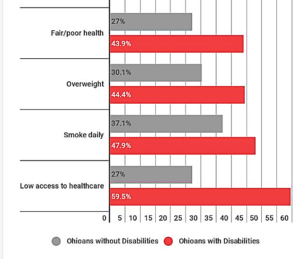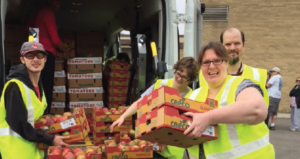Historically, health promotion efforts have overlooked people with disabilities (PWD). More often than not, health care providers and educators focus solely on a person’s disability rather than on the full range of health and wellness needs of each person as an individual. This leads to worse health outcomes for PWD when compared to people without disabilities.
Ohioans with disabilities are at greater risk for poor health (43.9%)(PDF), being overweight (44.4%)(PDF), and food insecurity. To address such health disparities in Marion County, community partners launched a mobile produce pantry that operates twice a month. Five neighborhood sites were selected based on community data and the USDA’s Food Access Research Atlas. Volunteers from MARCA Industries receive produce from Mid Ohio Foodbank, inspect, sort, and then deliver  produce into the community. OSU Extension augments the effect of the increased access by providing pantry recipients with recipes based on the produce they receive, incentives donated by Celebrate Your Plate, and by delivering other science-based health information through the Ohio Nutrition Education and Obesity Prevention Grant Program (SNAP-Ed). Other partners include Marion Public Health and Marion City Schools.
produce into the community. OSU Extension augments the effect of the increased access by providing pantry recipients with recipes based on the produce they receive, incentives donated by Celebrate Your Plate, and by delivering other science-based health information through the Ohio Nutrition Education and Obesity Prevention Grant Program (SNAP-Ed). Other partners include Marion Public Health and Marion City Schools.
Inclusion is improved and health disparities are reduced when PWD are no longer viewed solely as recipients of need but rather, by their assets and ability to design solutions that benefit their own health. In 2017, volunteers distributed produce to over 1,000 Marion residents (suspected that 25% experience a disability).  An additional 232 received nutrition education at accessible locations. In partnership with Marion Public Health and the Board of DD, a model inclusion policy was also developed, shared with, and adopted by 20 community organizations. Based on their inclusion policy, here are small accommodations that can lead to big changes in your own community:
An additional 232 received nutrition education at accessible locations. In partnership with Marion Public Health and the Board of DD, a model inclusion policy was also developed, shared with, and adopted by 20 community organizations. Based on their inclusion policy, here are small accommodations that can lead to big changes in your own community:
- Assess implicit bias in your community or workplace;
- Recruit self-advocates to serve on advisory boards and committees;
- Convene meetings and hold activities in accessible facilities;
- Ensure marketing efforts depict a diverse population of participants;
- Educate and advocate to community leaders on inclusion strategies.
What health disparities do you know of in your community? What have you learned from self-advocates who work and serve in your community? How will you design inclusive strategies? Share a comment in the section below or ask questions to learn more!

